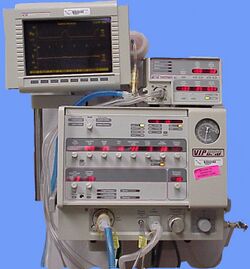Medicine:Rheotrauma
From HandWiki
Short description: Harm caused to a patient's lungs by high gas flows as delivered by mechanical ventilation

Rheotrauma is a medical term for the harm caused to a patient's lungs by high gas flows as delivered by mechanical ventilation.[1][2][3] Although mechanical ventilation may prevent death of a patient from the hypoxia or hypercarbia which may be caused by respiratory failure, it can also be damaging to the lungs, leading to ventilator-associated lung injury.[4] Rheotrauma is one of the ways in which mechanical ventilation may do this, alongside volutrauma, barotrauma, atelectotrauma and biotrauma. Attempts have been made to combine all of the mechanical forces caused by the ventilator on the patient's lungs in an all encompassing term: mechanical power.
References
- ↑ "Ventilator gas flow rates affect inspiratory time and ventilator efficiency index in term lambs". Neonatology 96 (4): 259–64. 2009. doi:10.1159/000220765. PMID 19478530.
- ↑ "Minimising ventilator induced lung injury in preterm infants". Arch. Dis. Child. Fetal Neonatal Ed. 91 (3): F226–30. May 2006. doi:10.1136/adc.2005.082271. PMID 16632652.
- ↑ Steven M. Donn; Sunil K. Sinha (19 December 2016). Manual of Neonatal Respiratory Care. Springer. pp. 314–5. ISBN 978-3-319-39839-6. https://books.google.com/books?id=E9HBDQAAQBAJ&pg=PA314.
- ↑ Asim Kurjak; Frank A. Chervenak (25 September 2006). Textbook of Perinatal Medicine, Second Edition. CRC Press. pp. 39–41. ISBN 978-1-4398-1469-7. https://books.google.com/books?id=qQpz7Oj5zZMC&pg=PA39.
 |

